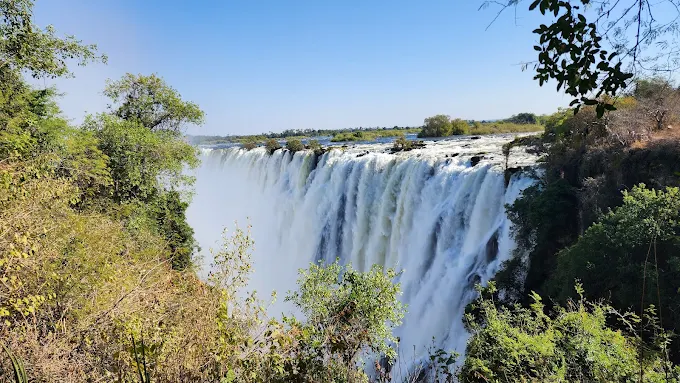Zambia’s Victoria Falls stands as one of the most breathtaking natural wonders in Africa and the world. Known locally as Mosi-oa-Tunya, meaning “The Smoke That Thunders,” this majestic waterfall is located on the Zambezi River, forming the border between Zambia and Zimbabwe. It draws millions of visitors every year who come to witness its immense power, stunning views, and the rich wildlife that surrounds it.
Victoria Falls is among the largest waterfalls on Earth, stretching approximately 1,708 meters wide and plunging 108 meters deep. Its vast width and impressive height create a curtain of water that produces a constant roar, which can be heard from miles away. The spray generated by the falls creates a mist that often results in vibrant rainbows visible throughout the day, adding to its magical atmosphere. Due to its outstanding natural beauty and ecological importance, Victoria Falls and its surrounding parks have been designated as a UNESCO World Heritage Site.
On the Zambian side, the falls are accessible from the town of Livingstone, which serves as a gateway for tourists. Livingstone offers numerous opportunities for visitors to explore the falls and engage in adventure activities. From guided walking tours that take travelers through the rainforest mist zone to thrilling experiences such as bungee jumping from the iconic Victoria Falls Bridge, there is no shortage of ways to enjoy the area. Helicopter flights over the falls provide an unforgettable aerial perspective of this natural marvel, revealing the full scale and majesty of the waterfall and the winding Zambezi River below.
The surrounding Mosi-oa-Tunya National Park is a key part of Zambia’s efforts to protect the unique ecosystem around Victoria Falls. The park is home to a wide variety of wildlife, including elephants, buffalo, giraffes, zebras, and numerous bird species. Visitors to the park can enjoy safaris and nature walks, gaining a deeper appreciation for Zambia’s rich biodiversity. The park’s conservation programs are closely tied to sustainable tourism, ensuring that the natural environment is preserved for future generations.
Victoria Falls holds deep cultural significance for the local people. The name Mosi-oa-Tunya reflects the power and awe inspired by the falls and is a reminder of the spiritual connection between the land and its inhabitants. Local communities play an important role in maintaining the cultural heritage of the area, while also benefiting economically from tourism. Handicraft markets and cultural tours offer visitors a chance to engage with traditional Zambian culture, enhancing the overall travel experience.
The volume of water cascading over Zambia’s Victoria Falls changes throughout the year. During the rainy season, typically from February to May, the Zambezi River swells, resulting in a spectacular surge of water that intensifies the roar and spray of the falls. This period offers dramatic views but can limit some walking paths due to heavy mist and slippery conditions. In the dry season, from around October to November, water levels drop, providing clearer views of the rock formations and allowing easier access to trails along the riverbank.
Tourism connected to Victoria Falls is a vital part of Zambia’s economy. The influx of visitors supports local businesses, including hotels, restaurants, tour operators, and artisans. The government and private sector have invested in infrastructure improvements to accommodate increasing tourist numbers while promoting eco-friendly practices. These efforts aim to balance economic growth with environmental protection, ensuring that Victoria Falls remains a sustainable destination.
Zambia’s Victoria Falls is not just a natural spectacle but a symbol of Africa’s commitment to preserving its heritage while welcoming global travelers. Its combination of awe-inspiring beauty, exciting adventure activities, rich wildlife, and cultural depth makes it a must-visit location for anyone exploring the continent. As the country continues to develop its tourism sector, Victoria Falls will remain a key attraction that highlights Zambia’s unique offerings on the world stage.







